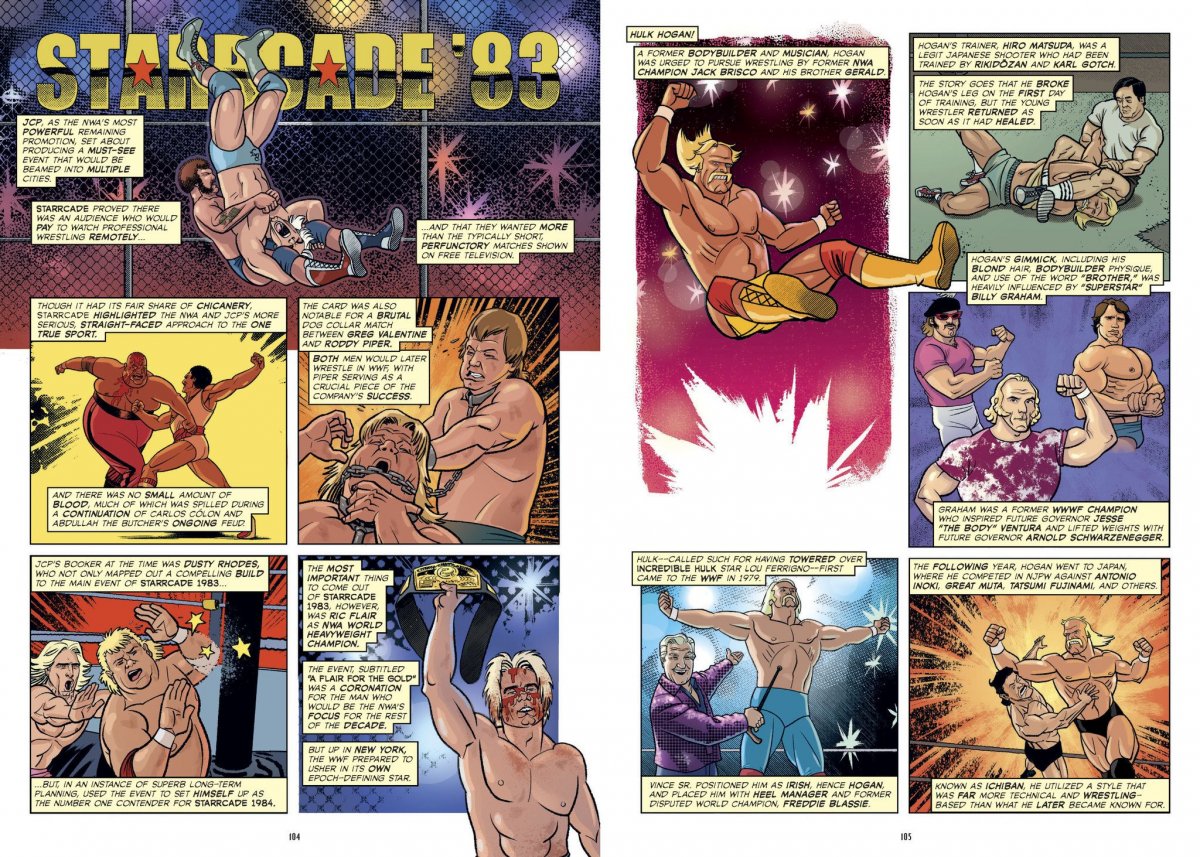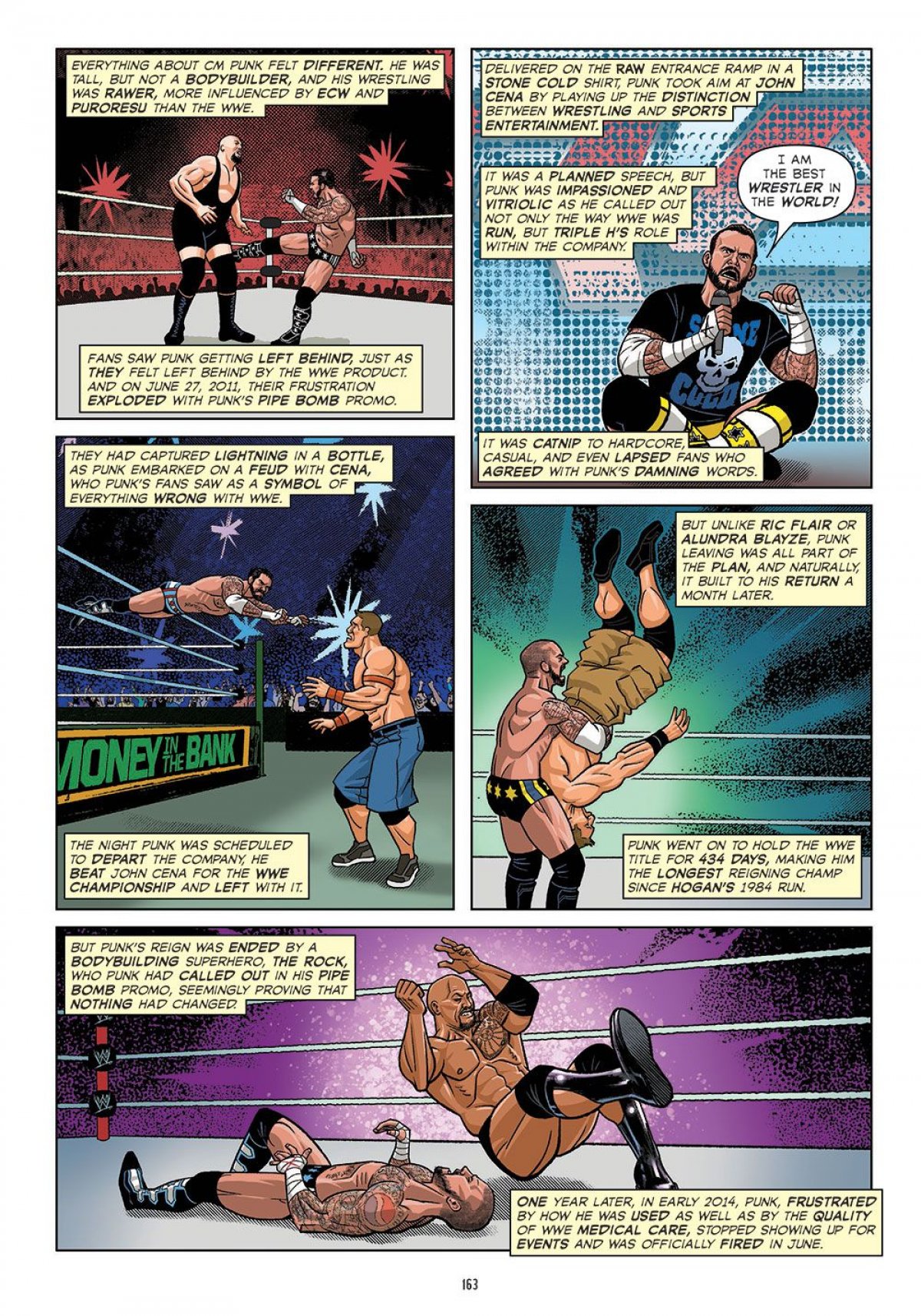In 1998, I watched The Undertaker throw Mick Foley from the top of a 20-foot steel cage inside the Civic Arena in Pittsburgh, Pa. I watched Foley get carried out on a stretcher, watched him get off it and climb to the top of the cage. Again. I watched him get thrown through the cage, an engineering malfunction that caused the top of the structure to break and Foley to plummet. Again. I watched him pour shiny thumbtacks on the mat and take bump after bump until his body glittered like a fish. He lost the match.
I've watched wrestling ever since.
I was not alone that day. Thousands in attendance (and millions watching at home) enjoyed the type of spectacle that only emerges when pro-wrestling hits a peak, as this came to be one of the defining moments of WWE's blockbuster Attitude Era in the mid-90s. A new graphic novel, The Comic Book Story of Professional Wrestling: A Hardcore, High-Flying, No-Holds-Barred History of the One True Sport, condenses this scene to just a single panel on one of its 170 pages. It is dense with history, but manages to take a measured approach to what it terms "the one true sport."

"It's called The Comic Book STORY of Professional Wrestling. This shouldn't just be a list of anecdotes. We need to structure it into a narrative," writer Aubrey Sitterson told Newsweek. Along with artist Chris Moreno, Sitterson crafted an illustrated history that isn't glorified fan service. Instead, pro-wrestling itself emerges as the main character. Dutiful summaries of styles, regions, and practitioners chart the evolution of "the one true sport." But how do you capture a century's worth of history for a mendacious profession? How do you separate fact from fiction, work from shoot?
"Everything is a work. Everything is designed to sell tickets, even the history books and the way people talk about who did what," Sitterson said."It was exceedingly difficult sometimes to separate the truth from the fiction. That's the heart of wrestling, this murky grey area between what we think is real and what we think is fake. And not being able to clearly delineate that is what makes wrestling excellent. It's what makes wrestling difficult to talk about in a definitive manner."

He was already "pretty deep in the weeds" with wrestling thanks to his time spent working for the WWE and hosting Straight Shoot, a podcast dedicated to wrestling. Sitterson found wrestler biographies to be a useful source, once he learned how to untwist the tall tales inside. While the wrestlers exploits involving themselves were often over-exaggerated, many recounted real moments in wrestling history. Old newspaper articles, especially in the era when pro-wrestling was covered as a legit sport, were also helpful.
"I found a few recordings of old matches being called off the radio," sitterson said. "When Bruno Sammartino won the WWWF title from Buddy Rogers, I listened to a radio recording of it."
So not only did Sitterson have the monumental task of finding accurate, honest information but Moreno needed to illustrate dozens and dozens of wrestlers. Easier said than done, especially considering many of the early influential figures in pro-wrestling rose to prominence in an era when photos were rare and television didn't exist. He relied on skillful caricature to keep things consistent.
"Being able to cartoon the figures was also important. I needed to extrapolate a lot from a small amount of resources. Some characters had a wealth of material but others it was just hazy, like a Bigfoot film of some of these guys. And to that end it was important to design them like characters because I needed to get more out of them," Moreno said.

Sitterson knows The Comic Book Story of Professional Wrestling won't make everybody happy. Inevitably, some fans will criticize the moments and figures he omitted (I personally chastised him for his failure to include legendary heel manager Jim Cornette in the book) but he is confident in his approach. He said the guiding light throughout the process was to adhere to the story they were telling, not the stories they wanted to tell.
"I tried to be pretty ruthless about it. If there was something I wanted to include but it didn't actually fit in with the narratives of the chapter and the overall narrative of the book we left on the cutting room floor," he said.
One such story involved "Big Cat" Ernie Ladd. A black wrestler, Ladd was a legend in the early '80s days of the Mid-South Wrestling promotion. He worked for promoter "Cowboy" Bill Watts, a man with a racist reputation because of the character he played in-ring. Sitterson said it wasn't wholly deserved. Watts feuded with another black star, Bobo Brazil, and often cut promos against Brazil that were ... well ... what you'd expect from an evil cowboy in the 60s. But Ladd's career under Watts, and Watts handling of black talent outside the ring, spoke to something else.
"Bill Watts' territory did more than any other territory to build massive black stars like Junkyard Dog and Butch Reed and Iceman King Parsons and, of course, Ernie Ladd, who not only became a star in Mid-South but became a booker. He was deciding how matches would go, and was the first black booker anywhere," Sitterson said. "That's a story I really love but I couldn't fit it in the book which really bummed me out."

The Comic Book Story of Professional Wrestling doesn't bill itself as an official history (hardcore, high-flying and no-holds-barred? sure). This is a smart move considering such a thing would be impossible. But it serves as good an entrypoint as any for new fans to learn more about "the one true sport" and offers plenty of interesting anecdotes and facts for learned fans as well. It might not be as spectacular as seeing Hell in a Cell live, but I'll be damned if it didn't put me in the mood to go watch some wrestling.
The Comic Book Story of Professional Wrestling: A Hardcore, High-Flying, No-Holds-Barred History of the One True Sport is available now on Amazon.
Uncommon Knowledge
Newsweek is committed to challenging conventional wisdom and finding connections in the search for common ground.
Newsweek is committed to challenging conventional wisdom and finding connections in the search for common ground.
About the writer
Mo Mozuch has been covering video games, culture and tech since 2012. Formerly the editor of iDigitalTimes and, later, Player.One, ... Read more
To read how Newsweek uses AI as a newsroom tool, Click here.








